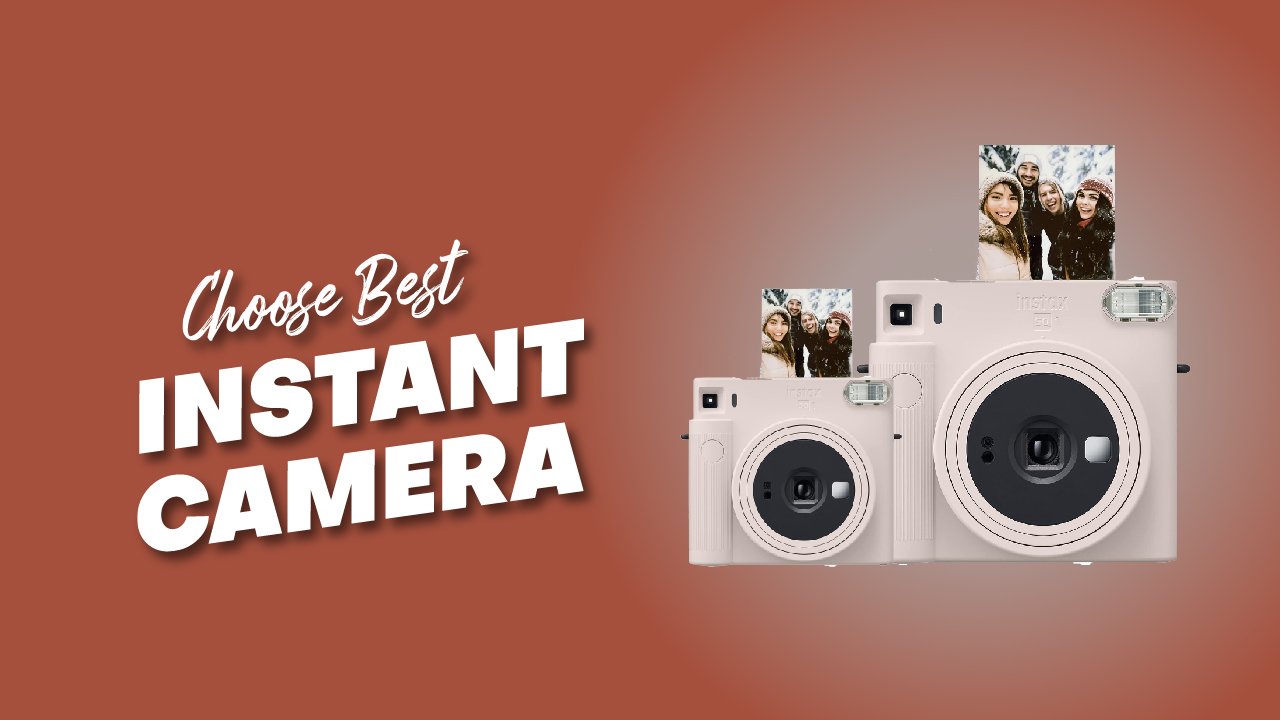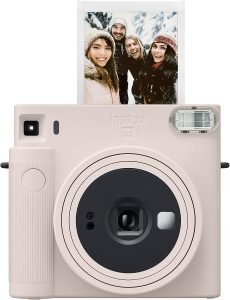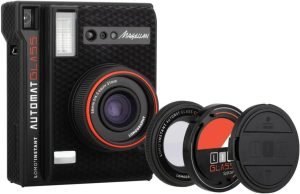
In search of an instant camera? It’s not just you. Instant film is still quite popular nowadays. Instax and I-Type films from Fujifilm and Polaroid are still produced today, along with the corresponding cameras.
The greatest quick cameras are so appealing to individuals of all ages and skill levels because of their simplicity. They produce some of the best cameras for both beginners and children since they are so simple to use.
The results are completely original; even Lightroom presets and Instagram filters can’t match the look that the greatest instant cameras produce. The dramatic low-fi images they produce using a conventional photochemical exposure technique are unique to instant film and feature crushed contrast, saturated colours, and ethereal exposures.
A brand-new generation of digital instant cameras likewise combines the excitement of instant photography with the practicality of contemporary technology. These hybrid instants feature both an integrated printer and a digital camera.
There are numerous justifications for using an instant camera. First and foremost, nothing in the digital world compares to the satisfaction of giving someone a physical snapshot you just took. Instant film may be a terrific way to save memories for posterity in a way that is different from simply another smartphone snapshot, which is why it is popular at weddings and gatherings.
Younger millennial and Generation Z photographers may also view it as a break from the digital rut and a new opportunity. In addition to a technique to keep any really private photographs out of reach of vulnerable cloud data services. Additionally, you can’t dismiss artists, who are constantly trying to distinguish their creations in a crowded field.
Continue reading for a list of the best instant cameras that have been evaluated, followed by a guide on choosing the best one for you.
The Affordable Instax Mini Cameras From Fujifilm:
Why It Was Selected?
The simplest and most economical method to try instant photography is with a Fujifilm Instax Mini 12. The all-plastic camera has a simple one-button operation, which is an improvement over prior models that needed the lens to be adjusted for different types of light.
Both online and offline retailers offer easy access to Instax Mini film, and both colour and black-and-white versions offer a wide range of creative opportunities.
Who It Is For?
If you simply want an instant camera, the Instax Mini 12 is the one to get. It should be fun for teenagers and college-age youngsters to use for remembering moments without worrying about leaving a digital footprint. And family photographers who wish to fill up a physical photo album or decorate their fridge are likely to love it.
1. The Best Instax Square Camera Is: the Fujifilm Instax Square SQ1

-
Why It Was Selected?
Because Polaroid 600 cameras were so prevalent in the 1980s and 1990s, older millennials and members of Generation X grew up with square instant prints. The SQ1 is the easiest way to use Fuji’s Instax Square format, which brings back nostalgic memories of square photography.
In comparison to current Polaroid models, this one-button variant takes colour or black-and-white film and has a reduced cost per image.
-
Who It Is For?
Photographers who prefer the square format should have no trouble appreciating the SQ1. It is a point-and-shoot camera with a plastic lens that takes good pictures. However, it isn’t the most adaptable choice. If you want an Instax Square camera with more manual control, go with the Lomo’Instant Square or the Nons SL660.
2. Lomography Lomo’Instant Automat Glass: The Best Glass Lens For Photographers:

Why It Was Selected?
We adore the Lomo’Instant Glass’ crisp wide-angle lens, which uses the same film as devices like the Fuji Instax Mini 12 but captures a wider scene with finer details. It’s an excellent option for photographers who enjoy snapping pictures of larger gatherings or who want to experiment with the stylish multi-exposure method.
Who It Is For?
Because the Lomo’Instant Glass is more expensive than the entry-level Instax Mini 12, it is not as likely to be an impulse buy. If you prefer the appearance of a wide-angle lens (its field of view is comparable to a 21mm full-frame lens) and require crisper prints than you can get with plastic-lens alternatives, it is worthwhile to invest extra money.
3. Lomography Best for Instax Wide Prints: Lomo’Instant Wide

Why It Was Selected?
Instax Wide produces the largest prints out of the three instant film types offered by Fuji. If you want to take quick and powerful pictures in that format, the Lomo’Instant Wide is the camera to buy.
Compared to the Fuji Instax Wide 300, it includes extra features geared towards artists, such as multiple exposures and a split-image attachment for the lens.
Who It’s For?
Lomography cameras typically cater to photographers with an artistic eye. Before you buy the Lomo’Instnat Wide, make sure you are familiar with the manual focus by distance settings and playing with the creative accessories. The final, large prints are worth the work.
4. Lomography Best Lomo’Instant Square For Folding Camera Fans:

Why It Was Selected?
One of the more eccentric instant cameras available today is the Lomo’Instant Square, but eccentricity isn’t always a bad thing. To create crisp, lovely prints, this quick folder combines a glass lens and Fuji Instax Square film.
Multiple exposures are helpful for artistic photographs, and the wireless remote that comes with the camera allows you greater latitude to set up selfies and group photos.
Who It’s For?
For camera aficionados, The Lomo’immediate Square is an immediate camera. For outings outside the house, you can throw the camera into your coat pocket thanks to its folding design, which is a throwback to Polaroids from the 1970s. You must calculate the subject distance and manually set the lens because it is a manual focus camera before taking a picture.
5. The Best Instant Camera With Interchangeable Lenses Is The Nons Sl660:

Why It Was Selected?
The Nons SL660 is worth a look if you yearn for the creative freedom provided by interchangeable lenses but still like the concept of Instax Square film. It produces better images than standard instant cameras with fixed, plastic lenses when using Canon EF glass.
Whom It Is For?
Photographers looking for unrestricted creative freedom might think about the Nons SL660. The flexibility to switch lenses creates photo opportunities for macro, wide-angle, telephoto, and blurred backgrounds that are just not possible with most quick cameras.
The SL660 is more expensive than the other items on this list, but we believe the outcomes justify the extra expense.
6. The Best for Traditional Polaroid Square Prints is The Polaroid Now+:

Why It Was Selected?
Although the majority of the instant cameras we suggest utilise Fuji Instax film, Polaroid is still an option if you’re okay with paying $2 for each photo. You get points for the money that are comparable to the square format of vintage SX70 and 600 series film.
The greatest camera you can buy that works with the brand’s contemporary I-Type film is the Polaroid Now+. Regarding features, this model offers extended and repeated exposures in addition to Bluetooth remote control.
A collection of lens filters is also included in the kit; you may use them to add a colour gel or to enhance the drama of black-and-white film’s skies, for example.
Who It Is For?
The Now+ should be most appealing to photographers with an artistic eye or intense affection for the original square-format Polaroid. The 3.1-inch square format is roomier than Instax Square (2.4 inches) and gives a full dose of artistic alternatives, including short-run materials like Black and Green Duochrome.
However, modern Polaroid film is a little more difficult to handle and utilise than Fuji Instax materials. The Now+ is a point-and-shoot camera with a plastic lens that offers some capabilities that are not available in the standard Now model.
Instead, photographers who want to revisit their Polaroid days with a semi-pro camera can consider a Retrospekt-restored SX-70.
7. The Best Digital Art Filters For On-Demand Prints With The Fujifilm Instax Mini Evo:

Why It Was Selected?
A digital-instant hybrid camera with a stylish retro design and outstanding plastic construction is the Fuji Instax Mini Evo.
Compared to analogue counterparts that use the same Instax Mini film, the digitally designed camera can operate in lower light and focus closer, and on-demand printing prevents you from wasting film on lost photo opportunities.
Who It Is For?
Anyone who wants to make instant prints should consider the Instax Mini Evo, but not for every shot. It is simple enough for anyone to learn how to use and comes with a tonne of in-camera filters for creatives.
The editing and file transmission restrictions Fuji incorporated into the system won’t likely be liked by professionals and photo amateurs, However, the rest of us can take pleasure in the lovely photochemical prints it creates.
8. The Best Retro Square Format Camera Is The Fujifilm Instax Square Sq40:

Why It Was Selected?
The Instax Square SQ40 and the less expensive SQ1 share the same camera features, including the usage of Instax Square film and one-button operation.
The SQ40 goes retro and features a more comfortable leatherette wrap, in contrast to the plastic SQ1’s brutalist aesthetics, which don’t make for an attractive camera.
Who It Is For?
The SQ40 is the Instax Square camera to get if you simply want one that looks good. It should be enjoyable to bring along to events and outings around town because it functions equally well as a fashion piece and a photography tool.
9. The Best One-Button Wide Format Instax is the Fujifilm Instax Wide 300

Why It Was Selected?
The Fuji Instax 300 is the camera to buy if you like the extra-large Fujifilm Instax Wide image format but prefer one-button, focus-free operations to the more manual Lomo’Instant Wide.
Just keep in mind that it does not offer multiple exposure and extended exposure settings like the Lomo’Instant Wide does.
Who It Is For?
If you wish to use Wide-format film without having to deal with manual controls, you should buy the Instax Wide 300. It’s also an excellent camera to bring to events like weddings or parties because the large film size yields keepsakes that are more memorable than those produced by the Mini format.
Also Read:
- 20+ Best Vlogging Cameras 2024: According To Vloggers
- How To Improve The Camera Skills Of Your Smartphone?
- How To Choose the Best Sling Camera Bag in 2024? According To Experts
Conclusion:
The early 1900s invention of the instant camera has recently experienced a resurgence. Taking a picture with your smartphone is very different from being able to quickly take one and have it in your hands. But nowadays, selfie features and applications that let you add filters and frames to your images have modernized instant cameras.
And once more, the instant photos are making a strong reappearance. Of course, printing a snapshot and passing it off as a souvenir or hanging it on the wall is always preferable to using a digital camera.
Above there are some of the best instant and Polaroid cameras that you can get.
Frequently Asked Questions(FAQ’s):
Q: Which is better Instax camera?
Ans: The Best Instant Camera
After additional testing, we’ve made the Fujifilm Instax Mini 12 our new top pick. The Fujifilm Instax Mini Evo remains our upgrade pick. Instant cameras embody the magic of photography: With the press of a shutter button, you can capture the world around you and see tangible results in seconds.
Q: Which Is Better Instant Camera Or A Digital Camera?
Ans: But the fundamental question is: What distinguishes Instant Cameras from Digital Cameras in terms of personalization? Both digital cameras and instant cameras produce quick results; the only difference is that instant cameras produce a hard copy of the image that you will keep with you for the rest of your life.
Q: Why Are Polaroids So Expensive?
Ans: Polaroid film is more expensive than Instax for a few reasons. Firstly, Polaroid film is more complex to manufacture than Instax film, requiring a greater number of chemical layers and a more precise production process. This higher manufacturing cost is passed down to the consumers, making Polaroid film more expensive.
Q: Is It Worth Buying An Instant Camera?
Ans: Yes, they will cost quite a bit more in the long run, as you’re using physical materials to “print” and “create” images. But, the experience and the results are worth the extra cost! And, I think, the limitation of how many photos you can take with an instant camera makes you appreciate each one all the more.
Q: Do Instant Camera Pictures Fade?
Ans: Do all instant camera prints fade? This is something that we can clear up straight away: Polaroid Originals prints and Instax prints will not fade any faster than any other kind of photograph if they are stored properly.
However, storing these prints properly requires slightly more care than regular photographs.





